Ride Physiology
Background
Imagine a passenger riding through a loop on a roller coaster. The
passenger's head is towards the inside of the circle.

Her feet are to the outside of the circle. In order to keep blood
in the passenger's head, a centripetal force needs to be applied to
the blood to push it upwards toward the head and the center of the
circle. The heart applies the centripetal force on the blood. A
passenger can experience many g's in a loop. Recall that a g is the
number of times heavier an object becomes. A 7 g experience means
that the passenger feels 7 times heavier. Everything about the
passenger becomes 7 times heavier. Her 3 pound brain now weighs 21
pounds. Every ounce of blood becomes 7 times heavier. If the blood
feels too heavy the heart cannot apply enough force to push it
towards the head. If the brain does not get any blood it will not get
the oxygen the blood carries. The passenger will pass out within a
second.
The Extreme Experience
You are riding a new untested roller coaster when something
goes wrong. As you enter the first big loop, a great pressure pushes
you down. You slouch down in the seat from the extra weight. Over the
top of the loop the roller coaster car slows down. The extra weight
on your legs, lap, and shoulder make it impossible to sense that you
are upside down. Out of the loop, over a hill and into another loop.
This loop has a smaller radius. The car is traveling much faster now.
As the g forces climb up toward 7 g's, you sink further still in the
seat. You can no longer see color. Everything appears in black and
white. An instant later, the passenger next to you disappears from
view. Your field of vision is shrinking. It now looks like you are
seeing things through a pipe. The front corner of the car disappears
from view as your peripheral vision disappears. The visual pipe's
diameter is getting smaller and smaller. You sink into the seat
further still as the number of g's climb further. In a flash you see
black. You have just "blacked out." You are unconscious until the
number of g's are reduced and the blood returns to your brain.
Amusement park owners and insurance companies do not want the
previously described situation to occur. It would limit repeat riders
and the number of potential consumers who can safely ride the
coaster. Most roller coasters keep the g's felt under 5 g's on an
inside loop or the bottom of a dip after a hill. When a rider travels
over a hill at a high rate of speed, he experiences negative g's. A
negative g is the multiple of a person's weight that is needed to
keep a rider in his seat. Negative g's also force the coaster car to
try to come up off the track. Negative g's are a rider's heaven and a
designer's nightmare. Negative g's are avoided as much as
possible.
A negative g has a different effect on a rider than a positive g.
Both negative and positive g's can cause a rider to pass out. But
negative g's cause a rider to "red out." A red out condition occurs
when there is too much pressure on the brain caused by too much blood
in the head. The extra pressure can cause blood vessels to burst and
kill the rider. This is a sure way to limit the number of repeat
riders.
There is another way for a rider to experience negative g's. It is
related to the length of the train. The roller coaster track is
designed for the dynamics at the center of mass of the coaster train.
Negative g's are experienced by the rider at the back of the train as
he travels over a hill. For an empty train, the center of mass is in
the middle of the train.Whatever speed is acquired by the center of
the train is the speed for the entire train. After the center of a
train passes over a hill it begins to gain velocity. As the center
speeds up so does the back of the train. This means that the rear of
the train will travel over the hill faster than the middle of the
train. If the rider travels over the hill faster than the designed
velocity of the hill the rear car will be whipped over the hill.
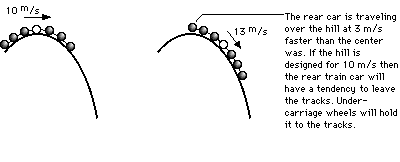
Some "g"
Determinators:
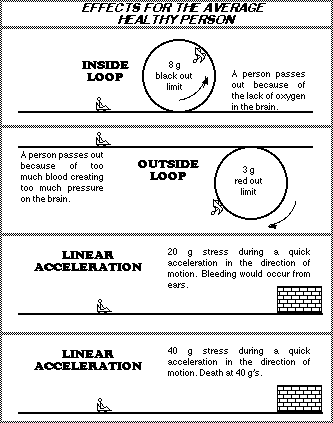
Calculation of the g's
felt
To calculate the g's felt, a formula from circular motion will be
utilized. Since energy relationships do not utilize time, the
circular motion formula used will also not utilize time.


Where "v" is the velocity of the body and "R" is the
radius of the circle traveled. To calculate the velocity a body is
traveling, use energy relationships to solve for the kinetic energy
and the associated velocity. One more thing. To calculate the g's
felt remember that the g's felt by the rider is the normal force on
the seat of the rider divided by the mass then converted into g's. As
a rider enters a loop he will feel 2 forces.
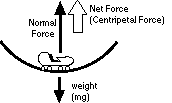
The real number of interest is the number if g's felt by the
passenger traveling in the vertical circle. The g's felt are
calculated below.
SFy = m(ac) = (Normal Force) - Weight
SFy = mv2/R =
(Normal Force) - mg
(Normal Force) = mv2/R + mg
recall that... (Normal Force)/mg =
g's felt by the rider
thus... (Normal Force)/g = mv2/R/mg + mg/mg
g's felt by the rider = (centripetal acceleration in g's) + 1
at the bottom
These results can be summarized as follows...
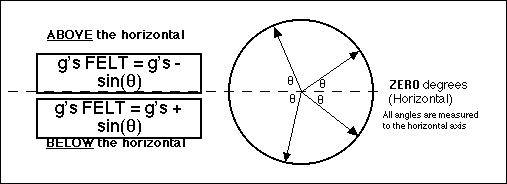
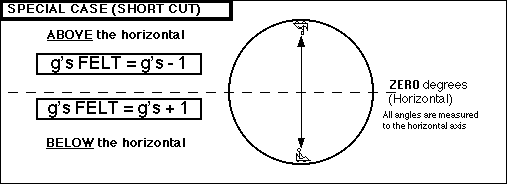
These results can be interpreted easily. As a rider enters the
loop, the track has to exert a normal force upwards to supply the
necessary centripetal force and acceleration to make the rider travel
in a circle. But because the loop is vertical and the rider is at the
bottom the normal force not only has to supply the centripetal force
but must also overcome the pull of gravity. That's why
1 g is added in the equation. At the top of the loop, 1 g is
subtracted from what is felt because the pull of gravity is helping
the normal force exerted by the track instead of needing to be
overcome.
If you use or find this page useful or have any
comments, please contact the author so maybe he'll do more.
Author: Tony Wayne
"ROLLER COASTER PHYSICS" TABLE
OF CONTENTS ... PHYSICS PAVILION TABLE OF
CONTENTS
<--PREVIOUS
SECTION ... NEXT SECTION
-->